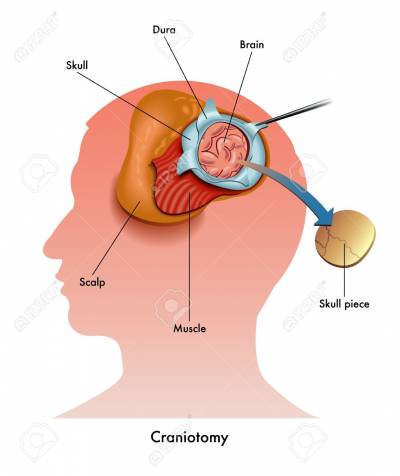A craniotomy is the surgical removal of part of the bone from the skull to expose the brain. Specialized tools are used to remove the section of bone called the bone flap. The bone flap is temporarily removed, then replaced after the brain surgery has been done.
Some craniotomy procedures may use the guidance of computers and imaging (magnetic resonance imaging (MRI) or computerized tomography (CT) scans) to reach the precise location within the brain that is to be treated. This technique requires the use of a frame placed onto the skull or a frameless system using superficially placed markers or landmarks on the scalp. When either of these imaging procedures is used along with the craniotomy procedure, it is called stereotactic craniotomy. An endoscopic craniotomy is another type of craniotomy that involves the insertion of a lighted scope with a camera into the brain through a small incision in the skull.
Craniectomy is a similar procedure during which a portion of the skull is permanently removed or replaced later during a second surgery after the swelling has gone down. Both procedures involve removing a portion of the skull, usually to perform surgery on the brain. The difference is that after a craniotomy the bone is replaced and after a craniectomy the bone is not replaced immediately.
Reasons for the procedure
• A craniotomy may be done for a variety of reasons, including, but not limited to, the following: Diagnosing, removing, or treating brain tumors
• Clipping or repairing of an aneurysm
• Removing blood or blood clots from a leaking blood vessel
• Removing an arteriovenous malformation (AVM) , An abnormal mass of blood vessels (arteries and veins
• Draining a brain abscess. An infected pus-filled pocket,
• Repairing skull fractures;
• Repairing a tear in the membrane lining the brain (dura mater)
• Relieving pressure within the brain (intracranial pressure) by removing damaged or swollen areas of the brain that may be caused by traumatic injury or stroke
• Treating epilepsy. A neurological condition involving the brain that makes people more susceptible to seizures
• Implanting stimulator devices to treat movement disorders such as Parkinson's disease or dystonia (a type of movement disorder).
There may be other reasons for a doctor to recommend a craniotomy.
Risks/Complications of the procedure
As with any surgical procedure, complications may occur. Brain surgery risk is tied to the specific location in the brain that the operation will affect. For example, if the area of the brain that controls speech is operated on, then speech may be affected. Some more general complications include, but are not limited to, the following:
• Infection
• Bleeding
• Blood clots
• Pneumonia (infection of the lungs)
• Unstable blood pressure
• Seizures
• Muscle weakness
• Brain swelling
• Leakage of cerebrospinal fluid (the fluid that surrounds and cushions the brain)
• Risks associated with the use of general anesthesia
The following complications are rare and generally relate to specific locations within the brain, so they may or may not be valid risks for certain individuals:
• Memory problems
• Speech difficulty
• Paralysis
• Abnormal balance or coordination
• Coma
REFERENCES
https://www.hopkinsmedicine.org/healthlibrary/test_procedures/neurologic...

